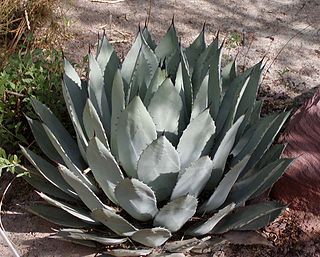
Agave americana, common names century plant, maguey, or American aloe, is a species of flowering plant in the family Asparagaceae, native to Mexico and the United States in Texas. It is cultivated worldwide as an ornamental plant, and has been naturalized in many regions, including parts of the West Indies, South America, Mediterranean Basin, Africa, Canary Islands, India, China, Thailand, and Australia.

Agave vilmoriniana, sometimes misspelled vilmoriana, and popularly known as Octopus agave, is a species of agave endemic to Mexico. It is known for its untoothed arching and twisting leaves.

Agave victoriae-reginae, the Queen Victoria agave or royal agave, is a small species of succulent flowering perennial plant, noted for its streaks of white on sculptured geometrical leaves, and popular as an ornamental.

Agave lechuguilla is an Agave species found only in the Chihuahuan Desert. The plant flowers once in its life and then dies.

Agave bovicornuta Gentry, is a plant in the genus Agave, native to mountainous regions in the Mexican states of Chihuahua, Sonora and Sinaloa. The common name Cowhorn Agave and the specific epithet refer to the prominent red spines along the edges of the leaves. Other common names include "lechguilla verde"

Agave mitis is a plant species native to the Mexican states of Hidalgo, Tamaulipas and San Luis Potosí, referred to as Agave celsii in many publications.

Agave salmiana is a species of the family Asparagaceae, native to central and southern Mexico. It is also reportedly naturalized in South Africa, Italy and Spain, specially in the Canary Islands.

Agave guiengola, common name "Creme Brulee Agave", is an evergreen plant belonging to the family Asparagaceae. This species is endemic to the State of Oaxaca, Mexico. It grows on limestone slopes, at an elevation of about 100–1,000 metres (330–3,280 ft) above sea level. It is associated with cacti and succulents. The species name guiengola refers to the Cerro Guiengola, the mountain where the species was first discovered.

Agave filifera, the thread agave, is a species of flowering plant in the family Asparagaceae, native to Central Mexico from Querétaro to Mexico State. It is a small or medium-sized succulent plant that forms stemless rosette up to 3 feet (91 cm) across and up to 2 feet (61 cm) tall. The leaves are dark green to a bronzish-green in color and have very ornamental white bud imprints. The flower stalk is up to 11.5 feet (3.5 m) tall and is densely loaded with yellowish-green to dark purple flowers up to 2 inches (5.1 cm) long. Flowers appear in autumn and winter.

Agave datylio is a member of the Agavoideae subfamily and a succulent plant. It is native to Baja California Sur.

Agave palmeri is an especially large member of the genus Agave, in the family Asparagaceae.

Agave polianthiflora is a relatively small member of the genus Agave, in the subfamily Agavoideae, endemic to northern Mexico.

Agave xylonacantha is a plant species native to Hidalgo, Tamaulipas, Guanajuato and Queretaro in Mexico, but commonly cultivated as an ornamental on other regions. A. xylonacantha is an easy-to-grow member of the genus Agave. The specific epithet 'xylonacantha' means "wood spines".

Agave shrevei is a member of the family Asparagaceae, indigenous to the Sierra Madre Occidental in Mexico, along the boundary between the states of Chihuahua and Sonora. Two subspecies are currently recognized, although a third has been proposed.

Yucca jaliscensis is a Yucca species native to the highlands of southwestern Mexico. Common names for this species include Jalisco Yucca, Jalisco Soapwort, Izote Yucca. It is native to mountainous areas at about 5000 feet in the States of Jalisco, Colima and Guanajuato.
Agave univittata, the thorn-crested century plant or thorn-crested agave, is a plant species native to coastal areas of southern Texas and northeastern Mexico, at elevations less than 100 m. It has been widely named Agave lophantha by botanists including Howard Scott Gentry, but the name A. univittata is older and therefore more in accord with nomenclatural rules of botany.

Agave havardiana is a plant species native to the Big Bend area of western Texas as well as Chihuahua and Coahuila. It prefers grassy to rocky slopes or woodlands at elevations of 1200–2000 m.
Agave gracilipes, common names Maguey de pastizal or slimfoot century plant, is a plant species native to western Texas, southern New Mexico and Chihuahua. It is found in grasslands, desert scrub and open pinyon-juniper woodlands at elevations of 1,200 to 1,900 m.

Agave decipiens, common names False Sisal or Florida agave, is a plant species endemic to coastal Florida though cultivated as an ornamental in other regions. The species is reported naturalized in Spain, India, Pakistan, and South Africa.

Agave atrovirens, called maguey verde grande is a type of century plant native to Oaxaca, Pueblo and Veracruz states in Mexico. It is the largest of all the Agaves, occasionally reaching a weight of two long tons. Each succulent leaf can be up to 14 feet 9 inches in length and weigh one hundred pounds (45 kg) apiece. In the variety A. a. cochlearis these leaves can also be up to 16 inches (41 cm) wide. As in other Agaves the leaves form a rosette, from the center of which, after many years, a panicle of flowers emerges on a long scape or peduncle which at first looks like a vast stalk of asparagus, but later grows to more than forty feet in height, develops side branches near the top and numerous flowers which open red and gradually turn yellow. Agave salmiana, the species with the tallest inflorescences, is frequently lumped with A. atrovirens as the varieties A. a. salmiana or A. a. sigmatophylla. If this is valid, then A. atrovirens also has the tallest inflorescences of any Agave, and of any known plant. Each rosette flowers and fruits once, then dies. According to Fayaz this is one of the species which makes offsets or "pups". A. atrovirens is one of the pulque agaves used in the production of mezcal.



















